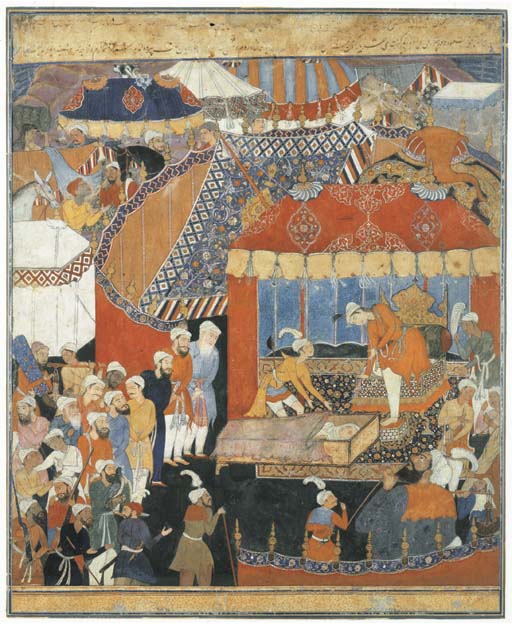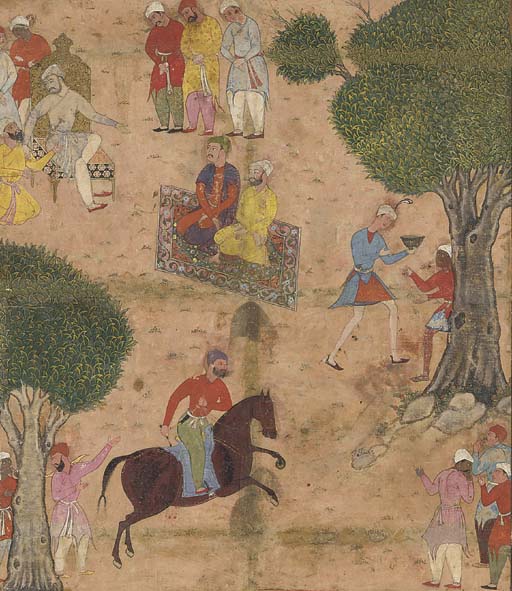

A leaf from Akbar's Hamzah-namah, an astonishing set of huge miniature paintings
Source: http://www.christies.com/LotFinder/search/searchresults.asp?sid=&SE=CMWCAT04+108237+298696484+&QR=M+1+80+Aqc0000900+98848++Aqc0000900+&entry=india&SU=1&RQ=True&AN=91&
(downloaded Sept. 2003)
"'UMAR COMES TO LOOK FOR THE BODY OF MIHR-NIGAR. Attributable in part to Shravana, Mughal India, circa 1560-1574. From the Hamzanama, gouache heightened with gold on canvas, 'Umar, Hamza's friend, comes to look for the body of Mihr-Nigar, who lies in a coffin within a tented enclosure, various attendants look on, two lines of text above written in black nasta'liq, rubbed, some losses of paint and retouching, mounted, framed and glazed. Folio 29 x 23¾in. (73.7 x 60.3cm.); miniature 25½ x 23½in. (64.2 x 59.7cm.).
Lot Notes: The Hamza Nama is a unique production, the largest manuscript of Persian poetry ever produced and the only one known which is painted on cloth. It was produced under the patronage of the Emperor Akbar from about 1564, for it was in this year that Abu'l Fazl records in the Ayn-i Akbari that extracts from it were read to the Emperor. Several eminent Persian artists of the 16th century were involved in its production, principally 'Abd al-Samad and Mir Sayyid 'Ali, both having left the employment of Shah Tahmasp.
This was one of the first major commissions of Akbar's reign, and is significant for introducing Iranian artistic conventions to Indian art, which was to have long-lasting influence on Mughal art.
The Hamza Nama tells the story of Amir Hamza, the uncle of the Prophet Muhammad, and is a fanciful blend of history and local legend. It is a popular collection of action filled stories, which originated in the Persian tradition of oral literature which flourished in the chaikhane. It is thought that the outline of the story was longer established in Iran even than that of the Shahnameh, with which it shares some anecdotes. Unlike the Shahnameh, there is no standard text of the work, which remained largely in the oral tradition.
It is painted on large sheets of cloth, with the images taking up most of one side and the text written in black nasta'liq on the reverse. It was in the Mughal Library up to the time of the sack of Delhi by Nader Shah in 1757, when many of the miniatures were sadly defaced. Some were taken to Iran, and others were dispersed. It appeared largely lost to the world until many folios were found in the late 19th century covering the windows of a Kashmiri teashop.
The manuscript originally comprised some 1400 folios of which about 200 are extant. A recent publication has brought together all the known surviving examples, and many of the paintings were exhibited at the Freer Gallery of Art and the Arthur M. Sackler Gallery, Washington, at the Victoria and Albert Museum, London in 2002 and at the Los Angeles County Museum of Art (Seyller, J.: The adventures of Hamza, London, 2002).
In this painting 'Umar, Hamza's friend, is looking at the corpse of Mihr-Nigar, the daughter of Anoushirvan, King of Persia and betrothed to Hamza.
Seyller places this miniature in volume 6 of the original commission.
Shravana was one of the most prolific painters working on the Hamzanama,
which is the major work by which he is remembered. Paintings ascribed to
him are also in the Cleveland Tutinama of around 1565-70 and the British
Library Darabnama of around 1577-80. His work is thought to have spanned
the period 1565-1600."

Another leaf from the Hamza-namah
Source: http://www.christies.com/LotFinder/search/LotDetail.asp?sid=&intObjectID=4351382&SE=CMWCAT03+1283153+%2D1428665045+&QR=M+1+46+Aqc0000900+1226168++Aqc0000900+&entry=india&SU=1&RQ=True&AN=47
(downloaded Sept. 2004)
"A FOLIO FROM THE HAMZANAMA. MUGHAL INDIA, CIRCA 1560-1574. Gouache on cloth, courtiers attend a figure seated on a throne in a landscape while a horseman rides across the foregound and a young man brings a bowl to a beggar under a tree, flaking, fold marks, areas of repainting, laid down on card with margins composed of seventeenth century gold illuminated manuscript borders with birds among flowers, framed and glazed. Miniature 21½ x 18½in. (54.7 x 47cm.)."
== Indian Routes index == Indian Routes sitemap == Glossary == FWP's main page ==